
The question most Frequently asked of us was why we ever wanted to write about clinical methods when there were so many other books already in the market. This is probably the right place to answer this question… As teachers and examiners in Medicine we had been aware for a long time of the unenviable position of the brilliant medical student who has learnt the method examination, the differential diagnosis, the significance of probabilities in their proper order. and the preferred investigations from foreign books, only to face the wrath of the examiner who is more realistically aware of the different local disease prevalence and diagnostic medical facilities. We have been aware too ofthe plight ofthe average medical student for whom English remains a relatively difficult foreignlanguage whose nuances are completely lost upon him and who needs to struggle not only withalready difficult concepts ofclinical Medicine but also has to decipher (subtle but significant) shadesof meaning which are obvious only to the native speaker of the English language; and a problemcommon to all students -the sequence ofnarration ofinformation given in books is very differentfrom what is taught and expected of them.
When faced with these problems the students resort to “notes” prepared by other students and full ofconceptual and factual errors, or booklets which are little better. They learn with great diligence
all that is contained within, the truth, half-truth and the gross untruth. They can go through life without ever realizing the myths and Fallacies they have imbibed. We thought it was time to address this problem, prompting us to write this book.
We have tried to make this book easily readable tor our students. We have tried to do away with concepts and material not relevant to local conditions and to put things in the proper perspective, keeping in mind the constraints operating here. But we have also tried to retain all material that the aspiring post-graduate might need. We have included a large number ofline drawings to illustrate concepts; what they lack in artistic quality we hope they make up in content and clarity, and should make learning relatively easier.
The initial interview with the patient and the results (history taking and presentation) is usually a particularly weak skill with our students and we have attempted to address this problem. We already have a publication which lists relevant questions to be asked of the patient according to the main presenting Feature and a synopsis of differential diagnosis in tabulated Forms (Aids to Diagnostic Process); this would be an excellent companion book to strengthen what we call “The Art of Relevance”.
There is a section on Pediatrics, not found in many current books. We think this is very timely mconsidering that Pediatrics will soon be a separate subject in the final professional MBBS examination,
Departing from the usual format, we do not have sections on X-rays and ECG interpretation. Studentsconsult these sections infrequently and very selectively, usually relying on the ward instructions. Wehave also not included examination ENT, Eye and Gynaecology. Examination in these specialtiestoo is usually learnt from single subject texts. This has helped in cutting the size and price, andimproving “portability” ofthis book.
During the whole process ofwriting of this book we have relied on Feedback from our students and young resident staff and we should like to continue this process so that subsequent editions can be responsive of reader preferences. We would appreciate any comment or suggestion that the reader might make.
Muhammad Inayatullah MRCP (UK)
Shabbir Ahmad Nasir FRCPE

